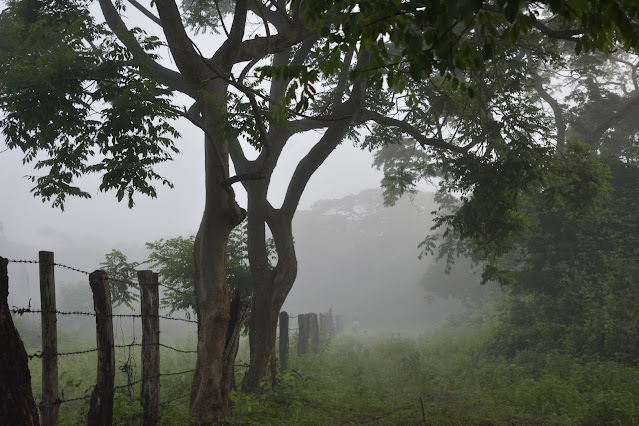Prologue
 |
| Morning mist at Hacienda Pelon. Photo: K. Perry. |
If you were to walk through the Lomas Barbudal dry forest of Costa Rica at dawn, you might hear the wa-WA-hehe wa-WA-hehe of a toledo bird duet (see video), or the hooting of a howler monkey troop. You might smell the minty scent of chan growing in the fields, or the acrid smell a stink bug leaves in the air. You might see mist filling up the distant valleys, or dewy cobwebs clinging to the barbed wire fences that separate forest from pasture. If you are unwary, you will almost certainly feel the prick of an acacia ant bite or a paper wasp sting as you push through the undergrowth. But if you wandered for a long time, you might come at last upon a tree in which small black shapes are beginning to stir in the early morning light. They are capuchin monkeys, and this is their story.
Underneath the capuchins is a group of humans, all staring intently into the treetops. If you asked in town, you would hear that they are the moneros, the monkey people. For thirteen hours a day, every day, they follow the monkeys through the forest, collecting data on their diet, their social interactions, and every other detail of their lives. The leader of the moneros, Susan Perry, has been studying the capuchins of Lomas for thirty years. She is my mother, and this is her story too.
Susan is a primatologist, a scientist who studies monkeys. She first came to Costa Rica in 1990, as a young graduate student, looking for a place to start a field site. She had chosen capuchins for her research because they are so smart—they have the largest brains in comparison to their body size of any primate besides humans. Susan wanted to know why capuchins needed such big brains. Over several decades of research, she’s come up with lots of answers to that question. Capuchins keep track of a huge variety of foods, their locations, and their fruiting times; they learn complicated procedures for opening these foods, some of which are encased in hard shells that even humans have trouble cracking; and they lead social lives as dramatic and treacherous as any soap opera star.
 |
| Napoleon, one of Lomas' wisest capuchins. Photo: S. Perry. |
The social drama, more than anything else, is what keeps Susan coming back year after year. She and her assistants develop a keen interest in the lives of their research subjects, so much so that former field assistants often ask for regular updates on their favorite monkeys long after they have left the project. The moneros introduced in the pages that follow are not from any one cohort, but represent some (but certainly not all!) of the most dedicated volunteers of the past few years.
In our next posts, we'll share a typical day in the life of a monero, from dawn until dusk.


Comments
Post a Comment